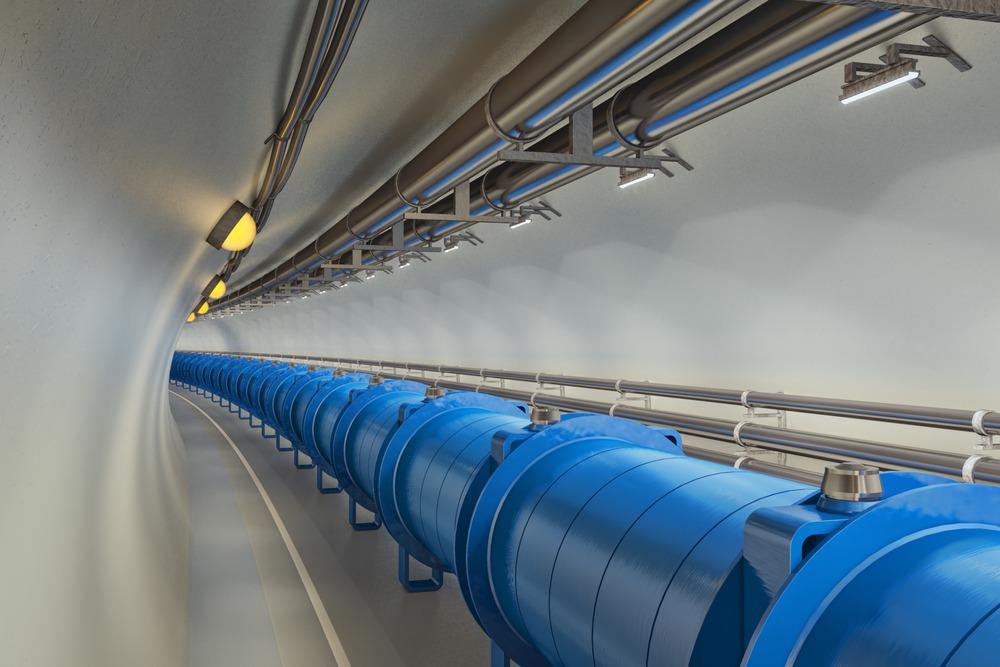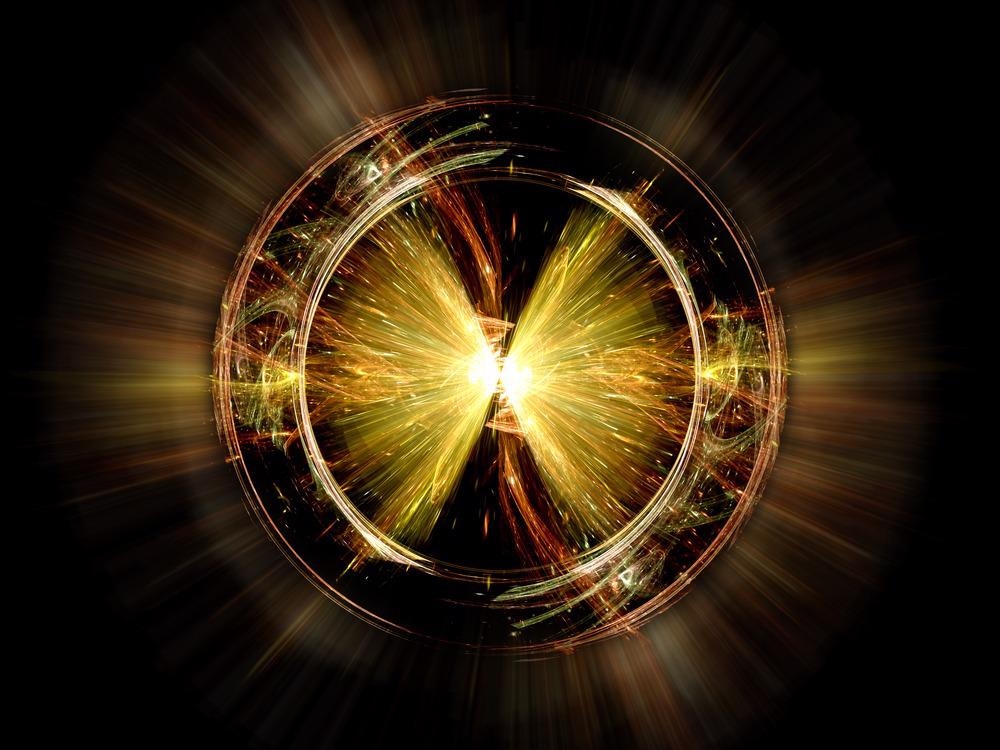CERN’s Large Hadron Collider is back online, bringing with it the possibility of new physics, a taster for a major upgrade that will be completed in 2029.

Image Credit: SSSCCC/Shutterstock.com
The world’s largest and most powerful particle accelerator, CERN’s Large Hadron Collider (LHC), just restarted operations after being closed down for three years while receiving an upgrade.
This will lead to three years of data collection after which the particle accelerator with its near 17-mile ring deep beneath the Franco-Swiss border near Geneva, Switzerland, will shut down again for further improvements.
The point of these upgrades is more intense beams, more particle collisions, more energetic collisions, and a chance to glimpse physics beyond the so-called standard model and recreate high energy conditions from in the early universe.
The LHC has already justified its existence by discovering the Higgs Boson — the particle that as part of the Higgs field grants other particles mass — in 2012, in the process of completing the so-called Standard Model of Particle Physics. This means that physicists are especially excited to see what the particle accelerator will deliver next.
Run 3: What is Happening at the LHC Today?
On April 22 at 12:16 CEST two beams of protons were circulated in opposite directions around the LHCs cycle at their injection energy of 450 billion electronvolts (450 GeV), marking the restart of the accelerator and a new era of physics.
The beams contained just a few protons with high energy collisions at least a few months away from resuming. This albeit small-scale demonstration represents the successful restart of the LHC after the hard work of a long shutdown.
The collection of data will begin in the summer at the start of Run 3 of the LHC, which is expected to last four years. Until then, researchers at the LHC will continue to upgrade the machine — arguably humanity’s most impressive science experiment — ramping up its beam energy and intensity.
This will result in the beams colliding to deliver record energy of 13.6 trillion electronvolts (TeV). The LHC was designed to achieve energies of 14 but it started off hitting energies of 7 TeV, increasing to 8 TeV, and then 13 TeV.
This 3rd run, understandably designated Run 3, will see the experiments at the LHC collecting data from collisions not only at record energies but also in unparalleled numbers.
CERN expects the ATLAS and CMS experiments to achieve more collisions during this run than in the other two periods of operation combined. In addition to this LHCb will see its collision count increase by three times. Most impressively, arguably, is the effect of the upgrade on ALICE — which studies collisions between heavy ions of elements like lead — which will now measure up to 50 times as many ion collisions as before.
Run 3 will also see new experiments commence at the LHC with FASER and SND@LHC, kicking off. These new tests are designed to look for physics beyond the Standard Model and will use special proton–helium collisions to measure how often the antimatter counterparts of protons are produced in these collisions.
The experiments will also use collisions involving oxygen ions to study cosmic-ray physics and even a state of matter called quark-gluon plasma — which existed shortly after the Big Bang — thus hopefully revealing conditions in the early Universe.
Run 3 will proceed until another shutdown, referred to as Long Shutdown 3, which will last until 2029. This will complete what researchers call the high luminosity upgrade stage (HL-LHC) of the accelerator.
The High Luminosity Upgrade: The Future of the LHC
Luminosity is an important factor of operations at the LHC as it describes the performance of the machine, and it is proportional to the number of collisions it achieves over a given amount of time.
The high luminosity upgrade is expected to increase the LHC’s luminosity by a factor of 10, with more collisions meaning more data and potentially more exotic particles being spotted.
One striking example of this will be the production of the Higgs boson, a particle synonymous with the LHC.
In 2017, the LHC created around three million Higgs bosons — impressive for a particle that had only been detected five years previously — but after the high luminosity upgrade in 2029, the HL-LHC will create an estimated 15 million Higgs bosons.
The planning for the high luminosity upgrade began in 2011 with contributions made from laboratories from CERN’s member States, as well as from the US, Japan, and Russia. The project was made top priority by European Strategy for Particle Physics in 2013.
The design phase for the HL-LHC ended in 2015 with civil engineering work starting in 2018.

Image Credit: sakkmesterke/Shutterstock.com
From 2029, the HL-LHC will be able to produce 140 collisions each time two-particle bunches meet at the heart of the ATLAS and CMS detectors. Before the upgrade, the LHC was able to generate just 30 collisions.
Achieving this requires a more intense and more concentrated beam, something that will be delivered at the HL-LHC by more powerful focusing magnets. These quadrupole magnets, capable of generating a 12-tesla magnetic field, will be installed on either side of the ATLAS and CMS experiments.
Twelve of these magnets are made of a superconducting intermetallic compound of niobium and tin, and will be installed close to each detector. Previously, the LHC’s magnets used a niobium-titanium alloy and could generate an 8-tesla magnetic field.
The HL-LHC will also be able to maintain beam luminosity at a constant level rather than suffering from the decrease in luminosity as protons collide it has experienced in the past. The particle bunches in the beams will also receive a kick at their heads and tails thanks to 16 added crab cavities that tilt the beam.
Other improvements include the replacement of the Linac2 beam injector with its successor, the Linac4 which was completed in 2020. The accelerator chain will also be bolstered by improvements to its three other links, the Proton Synchrotron Booster, the Proton Synchrotron, and the Super Proton Synchrotron.
When the HL-LHC fires up in 2029 there is no doubt that it will be one of the most exciting events in particle physics, but that doesn’t mean Run3 should be overlooked.
At the moment we don’t know what discoveries and innovations will be delivered by the LHC over the next seven years. And that is tremendously exciting.
More from AZoQuantum: The Role of Diamonds in Quantum Computing
References and Further Reading
Large Hadron Collider restarts, CERN, [2022], [https://home.cern/news/news/accelerators/large-hadron-collider-restarts]
Restarting the LHC: Why 13 Tev? CERN, [accessed 04/29/22], [https://home.cern/science/engineering/restarting-lhc-why-13-tev#:~:text=The%20LHC%20was%20designed%20to,years%20of%20maintenance%20and%20upgrading.]
High-Luminosity LHC, CERN, [accessed 04/29/22], [https://home.cern/science/accelerators/high-luminosity-lhc]
Pralavorio. C., Ground-breaking ceremony for the High-Luminosity LHC, [2018], [https://home.cern/news/news/accelerators/ground-breaking-ceremony-high-luminosity-lhc]
New technologies for the High-Luminosity LHC, CERN, [accessed 04/29/22], [https://home.cern/science/accelerators/new-technologies-high-luminosity-lhc]
Disclaimer: The views expressed here are those of the author expressed in their private capacity and do not necessarily represent the views of AZoM.com Limited T/A AZoNetwork the owner and operator of this website. This disclaimer forms part of the Terms and conditions of use of this website.